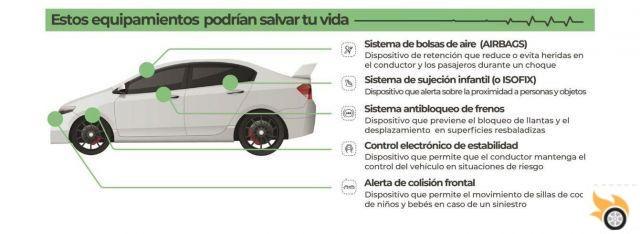
Car safety is a fundamental aspect that all drivers and passengers must be aware of. There are two types of vehicle safety: active safety and passive safety. Both play an important role in protecting people and preventing accidents. In this article, we will explore in detail the difference between active and passive security, as well as the elements that make up each one.
active security
Active safety refers to systems and devices designed to prevent accidents and improve the vehicle's maneuverability. These systems are active while the car is in motion and help the driver maintain control and avoid dangerous situations. Some of the most common active security elements are:
braking systems
Braking systems are essential for the active safety of a car. Anti-lock brakes (ABS) prevent the wheels from locking during hard braking, allowing the driver to maintain control of the vehicle. Another important system is stability control (ESP), which helps prevent skidding and understeer in corners.
steering systems
Steering systems are also essential for active safety. Power steering, for example, makes it easier to turn the steering wheel and improves the vehicle's maneuverability. In addition, there are active steering systems that automatically adjust steering based on road conditions and the speed of the car.
Illumination systems
Lighting systems are essential for safe driving, especially at night or in poor visibility conditions. Headlights, taillights, and turn signals allow the driver to see and be seen by other drivers. In addition, adaptive lighting systems automatically adjust the angle and intensity of the headlights based on road conditions.
Passive security
Passive safety refers to systems and devices designed to protect vehicle occupants in the event of an accident. These systems come into action after a collision has occurred and are designed to minimize damage and injury. Some of the most common passive safety elements are:
Body structure
The body structure is essential for the passive safety of a car. A strong and well-designed bodywork absorbs and distributes impact energy, thus protecting the vehicle's occupants. In addition, there are programmed crumple zones that deform in a controlled manner to absorb impact energy.
airbags
Airbags are passive safety devices that deploy automatically in the event of a collision. They are designed to protect the head and body of the occupants of the vehicle, preventing them from hitting the steering wheel, the dashboard or other objects. The air bags deploy quickly and gradually deflate to minimize the risk of injury.
Seatbelts
Seat belts are one of the most important and effective passive safety elements. They help keep vehicle occupants in place during a collision, preventing them from being thrown and reducing the risk of serious injury. In addition, there are pretensioner systems and force limiters that automatically adjust the belt tension based on the severity of the impact.
What are passive safety elements?
Passive safety elements are those systems and devices designed to protect the occupants of the vehicle in the event of an accident. These elements come into play after a collision has occurred and are designed to minimize damage and injury. Some examples of passive safety features are the body structure, airbags, and seat belts.
Systems most used in the car
In modern cars, there is a wide variety of passive and active safety systems. Some of the most used systems are:
Anti-lock Braking System (ABS)
The Anti-lock Braking System (ABS) prevents the wheels from locking during hard braking, allowing the driver to maintain control of the vehicle.
Stability control (ESP)
Stability Control (ESP) helps prevent skidding and understeer in corners, thus improving the safety and stability of the car.
Front and side airbags
The front and side airbags deploy automatically in the event of a collision to protect the head and body of the vehicle's occupants.
Seat belts with pretensioners and force limiters
Seat belts with pretensioners and force limiters automatically adjust belt tension based on the severity of the impact, providing greater protection for vehicle occupants.
Passive Safety Definition
Passive safety refers to systems and devices designed to protect vehicle occupants in the event of an accident. These systems kick in after a collision has occurred and are designed to minimize damage and injury.
Frequently Asked Questions (FAQs)
What is the difference between active and passive safety?
The difference between active and passive security lies in its function and moment of action. Active safety refers to systems and devices designed to prevent accidents and improve vehicle maneuverability, while passive safety refers to systems and devices designed to protect vehicle occupants in the event of an accident.
What are the most important passive safety systems?
Some of the most important passive safety systems are the body structure, airbags, and seat belts. These systems work together to minimize damage and injury in the event of a collision.
Conclusion
Active and passive safety are two fundamental aspects in the protection of the occupants of a vehicle. While active safety focuses on preventing accidents and improving the car's maneuverability, passive safety is responsible for protecting the occupants in the event of a collision. Both are equally important and work together to ensure safety on the road. It is essential that drivers are aware of the difference between active and passive safety, as well as the systems and devices that make up each one, in order to make informed decisions and drive safely.
We hope this article has been informative and useful. If you have any additional questions or comments, feel free to leave them below. We would love to hear your opinion!
Until next time!
The Pistonudos.com team


























